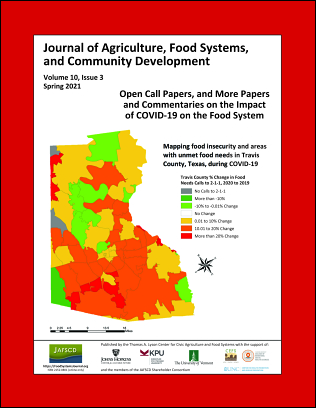Access to foods using Grand Rapids, Michigan, as a case study
Objective versus subjective issues
DOI:
https://doi.org/10.5304/jafscd.2021.103.008
Keywords:
Food Deserts, Food Access, Alternative Grocery, Public Transit, Perception of BarriersAbstract
Low access and low income are two of the primary factors used in determining the food desert designation by the U.S. Department of Agriculture. Low access is defined as a geographical area where 33% or more people are living beyond one mile from a supermarket in an urban region, and a low-income area is defined as one with a poverty rate of either 20% or more, or median family income falling below 80% of statewide or metropolitan area family income. These criteria have been in place for several years now. This study aims to assess the adequacy of these criteria for food desert designation and further investigate perceptions of barriers to fresh and healthy foods and measure physical ‘access’ for those reliant on the public transportation in the city of Grand Rapids, Michigan. The study includes a preliminary price comparative analysis of selected fresh foods in local grocery stores, spatial mapping using GIS to measure accessibility, and interviews with families at three schools located in food desert census tracts. Results of this study indicate that, first, there are other factors to consider when designating areas as food deserts such as public transit availability and inclusion of alternate food retail stores where fresh and healthy foods may be purchased, and secondly, perceptions of barriers to access fresh and healthy foods for families depend on mobility and cost preferences. Implications include a greater awareness of transit availability, alternate venues, acceptance of federal benefits such as SNAP-EBT, and incentivizing existing stores to sell healthier produce in disadvantaged areas.
Metrics
Downloads
Published
How to Cite
Issue
Section
License
Copyright (c) 2021 The Authors

This work is licensed under a Creative Commons Attribution 4.0 International License.
The copyright to all content published in JAFSCD belongs to the author(s). It is licensed as CC BY 4.0. This license determines how you may reprint, copy, distribute, or otherwise share JAFSCD content.













